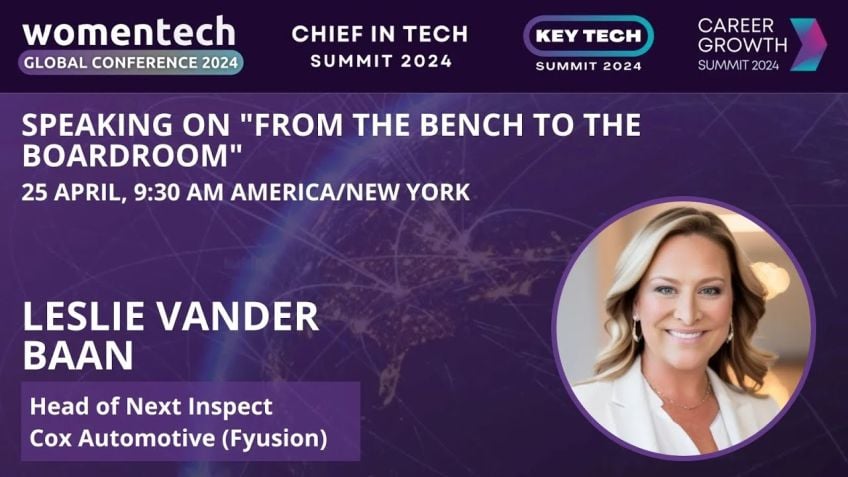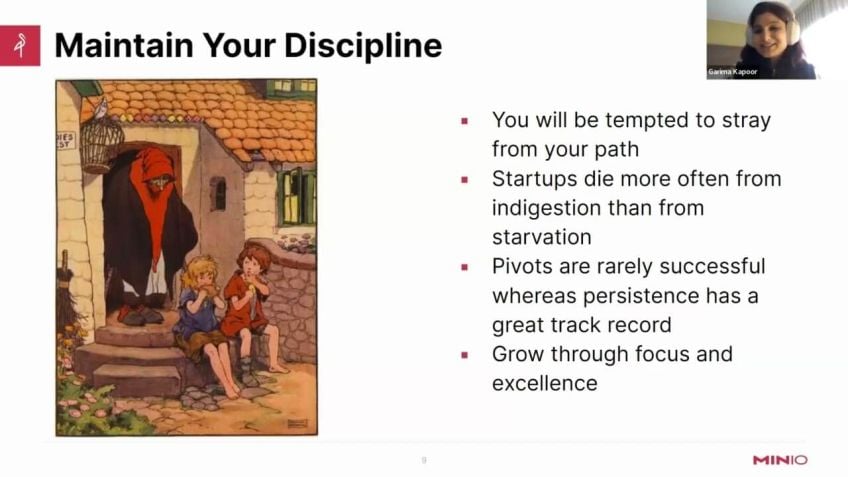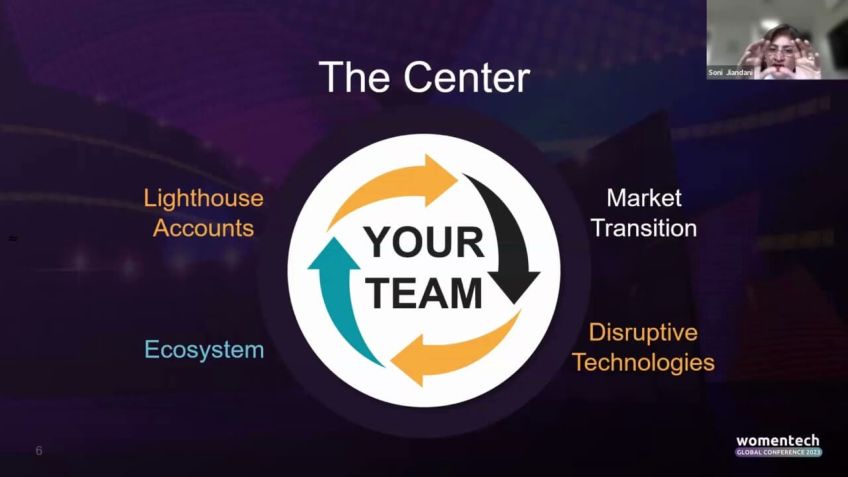Thriving on the edge: Entrepreneurship and Risk
Marina Tognetti
CEOUnderstanding Women's Perception of Risk in Technology
Hello everyone! This is Marina Tognetti, your tech entrepreneur and founder of mingle.com. We aim to bridge the gap between technology and the best teachers through our global online training school! But today, we will dig into an intriguing topic: the perception of risk and its impact on women’s participation in technology.
Did you know only 5% of tech start-ups are owned by women? It’s high time we understand why this figure lags and how we can influence change. We often associate risk with entrepreneurship and consider it uncontrollable. Yet, the reality is quite different. Successful entrepreneurs are calculated risk-takers. They know how and when to take risks. In this article, we're going to delve into why and how we can change this trend, focusing on the lessons I've learnt as a tech entrepreneur.
The Real Risk-Taker
The common perception of entrepreneurs often portrays them as daredevils or gamblers, but this is misleading. I believe that successful entrepreneurs are not born; they learn and cultivate their skill to take and manage risks. They can decompose risk, understand it, and reduce it to the maximum risk they can afford. So, the real question should not be about the maximum risk that you can take, but what is the minimum risk you can allow in your entrepreneurship?
Mindset, Skill, and Situation
Our comfort zones bind us, and as entrepreneurs, it is important to venture beyond these confines. Using a comfort-stretch-panic zone model, I'd like to show how different factors actually control our ability to handle risk.
- Mindset: This is our mental preparedness and will to accept a certain level of risk.
- Skill: The more equipped we are as entrepreneurs, the easier it will be to handle situations.
- Situation: This refers to the complexity of your idea or venture, it pertains to the internal parameters of the entrepreneurial ecosystem.
These factors determine whether you remain comfortable, are stretching beyond your known boundaries, or are entering the zone of panic.
Dealing with Entrepreneurial Risk
Reducing the Complexity of the Venture
The first step is to address and reduce the biggest risk elements. A significant factor contributing to a company's downfall is a lack of product-market fit. As entrepreneurs, we should be realistic about our initial ideas and open to changing them if the market demands otherwise.
Increasing Skills, Particularly Financial Skills
Financial skills are paramount to prevent bankruptcy – the grim fate of many start-ups. Through far-sighted financial planning, you can identify potential problems and take remedial action well in advance.
Changing Mindset towards Failure
Don’t let the fear of failure deter you. Very often, the fear itself weighs us down more than the consequences of the feared event.
Conclusion
In conclusion, we need to shift our perception of risk in entrepreneurship from uncontrollable to calculated. By adjusting our mindset, improving our skills, and prudently handling complex entrepreneurial situations, we can take more informed and reduced risks. Lastly, remember each entrepreneur's journey is unique, so focus on your path and don't get swayed by others' experiences. With understanding and careful management of risks, let's work together to improve the representation of women in tech entrepreneurship!
If you have any questions or comments, feel free to reach out. I'm always up for a stimulating conversation about entrepreneurship and technology.
Video Transcription
So good morning everyone. My name is Marina Tognetti and I'm a tech entrepreneur. I'm the founder of mingle.com, a global online training school where we combine technology with the best teacher to deliver training in languages, soft skills and teambuilding.Today, we're going to talk about risk because women have a different perception of risk and that hinders their participation in technology. Only 5% of tech start up are owned by women. Technology is revolutionizing every part of our society. Yet women do not participate in the revolution in a sufficient number. The question is why and what can we do about it? So what can we change in ourselves, which is under our control instead of waiting for society or business changes which are outside of our control? The answer here is in the risk, 90% of tear cafe. So if you're a first time entrepreneur, you have less than 10% chance of succeeding. Women tend to be risk averse when making decisions when men tend to be more risk prone. And that is why they start businesses and invest in the stock exchange. However, here is the good news according to a study by the London School of Economics, women start experiencing fewer failures when moving from early to growth stage, companies and men. And here is what I believe is the why the same characteristics that make us doubt too much at the beginning in starting a business are those that make us being more safe when making decisions later on. So taking less risk.
So you see the answer is always in the way we we we handle risk. So now it is the problem is that risk taking is always seen in, in not in the correct way. So entrepreneurship is always associated with this concept of uncontrollable risk while risk taking. So when I ask people about what does it mean to be an entrepreneur, they'll say, yeah, you need to be a risk taker and we asked them, what does it mean to be a risk taker? They answer and give example over dar devils or gamblers, but those answers are not correct. Successful entrepreneurs are calculated risk takers, successful entrepreneur know how and when to take risk. So what it means is that they know how to decompose risk to reduce risk. What you need to do is also understand the risk and reduce the risk to the maximum risk that you can afford. So the question is not so much over you know, what is the risk, maximum risk that that you can take? But actually what is the minimum risk you can allow in this situation? When you are playing in entrepreneurship. And here is an important thing, risk taking, it's not a threat, it's a process that means that it can be learned and I repeat it, this is very important. It's not a characteristic we are born with. It's something that actually can be learned along the way, something that can be educated and processed and improved. And it's very important to keep it in mind because this is not what common common sense rather to think.
So the question is how do we do to reduce risk taking or can do risk in an entrepreneurship situation? So let's start from some theory. There is a model, this is a model that has been used in uh in in coaching people to understand how people react to change. It's actually a model that I adapted for entrepreneurship and it's a model, the comfort stretch panic zone, how does it work? It says that everyone has a a zone, we call the comfort zone where we do things we are comfortable doing and where we are actually successful, this is the area of the norm. But as you know, entrepreneur, entrepreneurship is known being in a comfort in a known area. So this is normally when you have a job that you've been doing for long and you are already successful with it. In order to be entrepreneur, you have to be able to go outside your comfort zone into pushing yourself to your limits. When you go outside of your comfort zone, you go in what we call the stretch zone, stretch zone means you are capable of doing things. But it's still beyond what, you know, it's not the easy common work to do. This is the area that I called the one of control risk. So when you are actually able to handle the situation you're in, if you push yourself even further, you enter a situation where you actually don't know anymore what you're doing.
You don't, you don't have the right capabilities. You are not in a position where you can handle the situation you're in. And this is the area I call it the panic zone when you're in panic zone. This is the moment that the start up, fail, start up, go bankrupt. But also the moment that entrepreneurship, entrepreneurs decide to give up altogether. So this is the place where you don't want to be. Each zone has a threshold and the threshold for a zone is unique as this, depend on three unique factors. So this is a model I developed completely myself. And I say, ok, how do we identify when we are in one situation, the comfort or stress of or panic zone? And this depends on three factors. It is mindset, skill and situation. What does it mean? Mindset is really your uh mentality, your uh capability to accept a certain type of risk. It's really the the mind you have into taking risk skills is your ability to take the risk. Which means the more skills you have as entrepreneur or other business skills, the easier the situation is for you in situation is situation complexity, which means how difficult is your venture, your start up your company here, we're not talking about SWAT.
So external factor, we're really talking about internal factor of the entrepreneurship situation, which is logical. If you start as a first time entrepreneur, you might not want to start with a super complicated type of venture with a lot of uncertain factors. So the mix of the three determine where you stand in terms of being in a, in a let's say controllable situation or completely outside what you have is that when you actually possess all the three together, so you have mindset skills and situation situation is easy, you possess the right skill and you are completely comfortable.
You are in your comfort zone. Normally, when you get outside of that, it means that you are actually stretching. So you might not have one of the other characteristics. So you might have two of them mindset and, and skills or you might be in a great situation with the right skills, but you are scared as an entrepreneur or you don't have the skill, you know, don't have the mindset of entrepreneur yet. When you possess at least one or two of those criteria, you are in the stretch zone, it means you are still able to leverage something that is feasible for you in order to learn on the other two or to do things successfully when you are completely outside, it means outside of your mindset, your skill or situation that is when you get into the panic zone, it means you don't possess any requisite to be able to be successful.
And which means also logical that you're going to panic because there is nothing you can leverage to go to the next stage. Now this is the theory. So how do I apply it in practice? The important thing here is to see over how can you move? In fact, the the key question is how can you move from a comfort zone to the biggest possible stretch zone? You can understand that of course, the biggest the stretch zone is which is the area where you can move as entrepreneur, the better it is for you because it means you can go much further and learn more and develop more. The comfort zone is a zone where you don't learn. So you need to go outside of the comfort zone to learn, you need to go outside in order to be entrepreneur. So how do you move from, let's say where you are or where, where you want to be? The question is over influencing some variable. And so the question comes, if we know we have three variable mindset skills and situation, what can you actually influence? And the good part of it that you can influence all three of them. That's why they are key drivers here.
I will give you some example, gave from my own personal experience with my own company. And the good news is that for me that my own company didn't go right from the beginning. So actually, whatever I learned along the way, something that I put in my own model to develop and help people who are in a more difficult situation. So the point is as long as everything goes fine, you might not even realize that you need to think deeper about risk. But it's when things are going wrong or things are going difficult or when you realize that this is not, I expect it to be, that is the moment you need actually to take a step back and understand over. OK, how, what do I need to change what I'm doing now? So let's go one by one and I will give you really practical examples. Let's start from situation situation is the amount of risk that is in the specific venture or entrepreneurships. Uh The entrepreneur uh idea that you are actually executing. So the complexity, what you need to do is reduce the complexity, address the single biggest amount risk elements and reduce them. Number one, the biggest reason why company fail is lack of product market feed.
And that has been discussed in all entrepreneurship books in the Silicon Valley and all in start up. They all say, but sometimes say is different than being executed. I saw a lot of, of our entrepreneurs, they, they get in love with their own initial idea and they are not actually able to see it realistically for what it is. They are not able to let it go. So the first thing you need to do as entrepreneur is really find product market feed thing. Number one really look carefully to your idea. And if you see that it doesn't have traction, it doesn't work, it doesn't resonate with customer. You have to admit you have a problem. And that's the most difficult thing for an entrepreneur. When we launch Mingle, we launch Mingle like a marketplace, which is something I knew very well from my previous E ebay experience. So, and we got it all. We got funding even before we launched the company, I got a very motivated team. We start winning a lot of awards. We had a lot of pr so everything seemed like going perfectly. It was only as you think of it, what can possibly go wrong. And what we noticed is that we were spending a lot of money in marketing and in everything and we're not getting the expected results. So it was growing but very, very slowly, despite all the effort and money we're putting in.
So that's the moment I had to go back and say something in the business model is not working properly. I called my team back and I said, ok, let's stop everything we're doing. Let's stop spending so much money in Google ads and everything else we're doing. Let's go back to the drawing board. So we start talking to the customers and we start asking the question over. Yeah. What's wrong with our product? What, what's going on? And the answer was always the same. What they were telling us was if, if you buy a product from ebay, you know, if the product, if the system is good or bad, you know, if the product works, you know, if a good product, if it's delivered in time, you know, it's ok. So you as a customer, you are able to judge the quality of the supplier. But for a complex product like languages now, even more for soft skills, how can a customary student judge the value of the teacher? What they were telling us is even if a teacher is nice and friendly, that doesn't necessarily mean that the teacher is able to teach. So we will discover only later on weeks or months later that actually we had a lot of fun, but we didn't learn anything. So the point here was we needed to understand that there was a big difference between an open market place like we created for mingle and something different.
That was a service as a soft service of things that people didn't understand or were not, not able to judge so we understood that. And so the the answer was mingle to assume responsibility for the quality of the teacher, not the students, not the ranking system, not the marketplace. And so that brought and it is in a different place. We first of all to became a quality platform. So we kicked out also, you know, 80 90% of the teacher and changes a lot of our process. And then we move and became really a school, a kind of online school. And that brought us in a different place where company more than consumer, where were buying the products that we are, uh we're offering. So then I started realizing, OK, you know, now I have the market, the market is not consumers, but it's a B to B market, it's corporation, it's, it's business people that are buying for it now. So at the market. So what is the right product for the market? And here we applied exactly the theory. I didn't know at the time that this was a theory of minimal viable product. At the time, the theory didn't exist because it's like 10 years ago or more. But what I realized is I build mingle from my own head.
What I wanted, what I thought was right for ebay like ebay, what will happen if I add my customer? So we took a pilot customer and we asked the customer, they didn't know they were a pilot that they thought we were you know, a solid company. But we ask them, ok, what do you want from us to have the perfect product for training employees? And they come back and they say I want an assessment at the beginning to know where they start. I want an assessment at the end, I want an account manager. I want to report in every single month to see how my students are doing. I need a lot of things, extra things that we didn't have in the consumer platform. So what we did, we just improvised. So I took one of my guys of marketing and I say Stefano from now on you are the account manager for the B to B business and just do whatever the customer asks you. And so we did it unconsciously, I executed a minimum buyable product because we did it all manually. So we did exactly what this the customer was asking but did it. We didn't program it yet. We first started by, at the end of every month, the poor Stefan was building big spreadsheet where it was putting data of all our customers, send it to a chart, it was building and we're making analysis. We're doing everything manually.
But what it meant is that we really built a product around the customer need and we didn't waste time in building things of each other, the customer didn't need. So it looks very obvious, backwards, looking backward. But mostly this is not the way the company are built or entrepreneurs start with their own product, they normally start and they build whatever they think is right. So go back to the opposite way and do it really the right way. So this is number one in one tip about situation number two, it's about increasing skills. So as an entrepreneur, you need to possess a wide variety of skills, but one important skill that you cannot miss is financial skills. Why issue number 21 of the biggest things, the reason why start fail and go bankrupt is they don't have enough money to pay for the support in the company. And the good news here is that actually financial can be learned. Financial is one of the easiest skills to learn. And so it's something that you can, you can learn from somebody from the expert, you can even get a book, you can learn how to do it. And that's one of the things that people tend to ignore or tend to, you know, to, to postpone to later on now, you need to get confident with financial number. The first thing you need to do is really looking far ahead.
So what happens in many start when they fail is that they realize in two months from now three months from now, I don't have money. That's way too soon. You're not going to be able to make any changes. Uh In 23 months, there is no way you actually can improve anything. So what you need to do is look far ahead. Uh eight months, nine months, one year ahead, make a projection for one year. If you realize you have a problem one year from now today, you can take action to improve the situation, not when it's in two months ahead. So that that is what I realized with mingle. I saw it coming. I think it was about 89, 10 months ahead. That is ok. We're going to go really negative in cash flow. And my investors of course were like, no, we're not going to, you know, invest in you if you are not able to support your business. So here is also the bad news, you know, you're not going to receive investment when it's going wrong, you're only going to receive investment but it goes right and you're growing. So you need as entrepreneur to be able to look ahead and make plans. So what I did, I just built financial spreadsheet, I had a financial spreadsheet, but I really went deep down. So you have to do that also start you with every single cost, built it up by category. So really create a financial model.
It's a up to your profit and loss but profit and loss is not important. Cash flow is the most important projection you can make as entrepreneur. So go to your cash flow projection every single detail put it in always estimate, maybe a little bit more than a little bit less and then you can take action. So I built it really bottom up and I create this financial spread where I say, OK, we're going to be 1 200,000 negative in, in eight months from now. I need to start taking action now and then the negative is going to get even worse. So what you have to do is if you see a problem ahead, take action now and take action on the cost because what many entrepreneurs also do, they start being, you know, wishful thinker, they say, ok, but maybe we will sell more, maybe this client will come in time and we say, don't play your, your the safety or the, let's say the life of your company only maybe played on the cost.
The cost is actually the only variable that you can control 100% all the rest. It's just, you know, hopeful and wishful thinking. So we took all the action, what we did, we start putting a lot of services offshore, you know, being located in, in, in the Netherlands, in Amsterdam all over, you know, personnel costs and everything was very expensive. We put fully programming customer support, any supporting activity, we put it offshore in much cheaper countries. We went back to our suppliers, we renegotiate every single contract with the suppliers. We cut on the extra cost if we didn't need it. And I even had to fire people, it was needed actually to fire people simply because the new business model couldn't afford, you know, the big stuff that I built from the beginning. When you find funding, you normally tend to overinvest in creating a new position and stuff. And I remember it was really in, in tears of fighting people was really heavy. I, you know, IIII I shed a few tears myself but people didn't take me negative. And I remember we had the the farewell party for the people that, that I had to let go. And really one of those people raised the glass with wine and say, you know, I wish you guys that you really make it because you deserve to make it.
So if you do with transparency for your team, you say, OK, we need to cut a few to save the rest and to save the company, people can actually see it. You have to be the first one to cut, you have to be the first one as entrepreneur to make the sacrifice and then your team will follow you. So this is about finance, get knowledge of finance as soon as you can. The third thing is change mindset and this might be the most difficult to do, but it's not impossible and it's in the mind of the people that you actually cannot change mindset. Yes, you can. The biggest problem entrepreneurs have is fear of failure. And that's probably something that resonates even more with women. We are always scared that are we good enough? Are we going to make it? And with my company mingle, I was in a really bad place when I was executing the plan. Yes, I know I had a plan but I was really scared, I was scared of going bankrupt. It was my first entrepreneurship experience. So I was, I was really scared. I went to a psychologist and then he asked me over, what are you really scared about? I say I'm going to go bankrupt. Say what happens if you go bankrupt? Say uh uh bad is bad. What, what does it mean? Are you going to lose your house and going to live on the street?
I say no, I have, you know, low fixed costs and I have enough saving to, to survive. Uh What's going to happen? Your family friend, boyfriend is going to leave. You say no, my my friends uh care about me as a person. So it doesn't, doesn't matter. So what do you really fear? And I was thinking about myself, I say I fear that people would judge me as a failure. And I say which people, your friends? No, no people, I don't know. So then he, he summarized and say so what you tell me is the worst thing that can happen is that people you don't know who probably don't even care about what you're doing, who have their own problem to take care of, they might even judge that you are a failure because your company go bankrupt and that's the biggest risk you're actually failing right facing.
And then when I realize I say, wow. Yeah, that actually it's not that bad. And if you put yourself that question, you ask yourself what's the worst that can happen, then you realize that actually in many, many cases, not as big as you think. So the, the, the fear itself is often bigger than the consequence of the fear. And that really put me in a different state of mind when I was OK, then OK, I'm going to execute. I'm going to do the best I can, I cannot do more than that. What that can happen is I will start a new company another time. So this is uh three tricky tips I wanted to give to you. I want you to close with one general tip and that is do not compare yourself to anybody else. We are always exposed to the beautiful story of Mark Zuckerberg, Elon Musk or all the genius that you know, float around in Silicon Valley. And then we feel inadequate. We also compare ourselves to anybody else, maybe even to people presenting at this conference who are one step ahead who are different or in a different situation, every situation is different. And if you understand my mother really deteriorate behind it, you know, mindset skills situation, all three of them are different. Your company, your skills, your yourself is different. So no situation is the same.
So don't look at anybody else, look at what you can do with the, with the elements you have in your hand. So I wanted to close the presentation saying that I'm using and going around talking about risk because this is something women fear a lot. And I hope that by giving my example, also the company that went from, you know, possible failure to success, I can stimulate more people or more women also going into the entrepreneurship route so that together we can change the statistics, both the 90% but especially the 5%.
Thank you. And now if there are any questions, I will go back to the present to the to your presentation.






